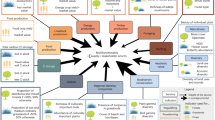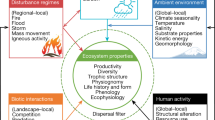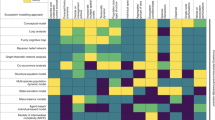Abstract
Recent years have seen a surge of interest in ecosystem multifunctionality, a concept that has developed in the largely separate fields of biodiversity–ecosystem function and land management research. Here we discuss the merit of the multifunctionality concept, the advances it has delivered, the challenges it faces and solutions to these challenges. This involves the redefinition of multifunctionality as a property that exists at two levels: ecosystem function multifunctionality and ecosystem service multifunctionality. The framework presented provides a road map for the development of multifunctionality measures that are robust, quantifiable and relevant to both fundamental ecological science and ecosystem management.
This is a preview of subscription content, access via your institution
Access options
Access Nature and 54 other Nature Portfolio journals
Get Nature+, our best-value online-access subscription
$29.99 / 30 days
cancel any time
Subscribe to this journal
Receive 12 digital issues and online access to articles
$119.00 per year
only $9.92 per issue
Buy this article
- Purchase on Springer Link
- Instant access to full article PDF
Prices may be subject to local taxes which are calculated during checkout

Similar content being viewed by others
Change history
13 August 2018
In the version of this Perspective originally published, in the figure in Box 3 the middle panel of the top row was incorrectly labelled ‘50% threshold-plus’; it should have read ‘50% threshold’. This has now been corrected.
References
Odum, E. P. Fundamentals of Ecology (Saunders, Philadelphia, 1953).
Hector, A. & Bagchi, R. Biodiversity and ecosystem multifunctionality. Nature 448, 188–190 (2007).
Zavaleta, E. S., Pasari, J. R., Hulvey, K. B. & Tilman, D. Sustaining multiple ecosystem functions in grassland communities requires higher biodiversity. Proc. Natl Acad. Sci. USA 107, 1443–1446 (2010).
Fischer, M. et al. Implementing large-scale and long-term functional biodiversity research: the Biodiversity Exploratories. Basic Appl. Ecol. 11, 473–485 (2010).
Baeten, L. et al. A novel comparative research platform designed to determine the functional significance of tree species diversity in European forests. Perspect. Plant Ecol. Evol. Syst. 15, 281–291 (2013).
Clough, Y. et al. Land-use choices follow profitability at the expense of ecological functions in Indonesian smallholder landscapes. Nat. Commun. 7, 13137 (2016).
Nelson, E. et al. Modeling multiple ecosystem services, biodiversity conservation, commodity production, and tradeoffs at landscape scales. Front. Ecol. Environ. 7, 4–11 (2009).
Bateman, I. J. et al. Bringing ecosystem services into economic decision making: land use in the United Kingdom. Science 341, 45–50 (2013).
Byrnes, J. E. et al. Investigating the relationship between biodiversity and ecosystem multifunctionality: challenges and solutions. Methods Ecol. Evol. 5, 111–124 (2014). Reviews the current methods for measuring multifunctionality in biodiversity–ecosystem function research.
Allan, E. et al. Land use intensification alters ecosystem multifunctionality via loss of biodiversity and changes to functional composition. Ecol. Lett. 18, 834–843 (2015). Shows that the relationship between multifunctionality and its drivers depends on stakeholder priorities and the weighting of different functions.
Mastrangelo, M. E. et al. Concepts and methods for landscape multifunctionality and a unifying framework based on ecosystem services. Landsc. Ecol. 29, 345–358 (2014).
Bradford, M. A. et al. Discontinuity in the response of ecosystem processes and multifunctionality to altered soil community composition. Proc. Natl Acad. Sci. USA 111, 14478–14483 (2014). The first paper to question the capacity of multifunctionality measures to represent overall ecosystem function..
Bradford, M.A. et al. Reply to Byrnes et al.: Aggregation can obscure understanding of ecosystem multifunctionality. Proc. Natl Acad. Sci. USA 111, E5491 (2014).
Byrnes, J. et al. Multifunctionality does not imply that all functions are positively correlated. Proc. Natl Acad. Sci. USA 111, E5490 (2014).
Sala, O. E., Jackson, R. B., Mooney, H. A. & Howarth, R. W. (eds) Methods in Ecosystem Science (Springer, New York, 2000).
Magurran, A. Ecological Diversity and its Measurement (Springer, New York, 1988).
Petchey, O. L. & Gaston, K. J. Functional diversity: back to basics and looking forward. Ecol. Lett. 9, 741–758 (2006).
Gamfeldt, L., Hillebrand, H. & Jonsson, P. R. Multiple functions increase the importance of biodiversity for overall ecosystem functioning. Ecology 89, 1223–1231 (2008).
Duffy, J. E. et al. Grazer diversity effects on ecosystem functioning in seagrass beds. Ecol. Lett. 6, 637–645 (2003).
Isbell, F. et al. High plant diversity is needed to maintain ecosystem services. Nature 477, 199–202 (2011).
Lefcheck, J. S. et al. Biodiversity enhances ecosystem multifunctionality across trophic levels and habitats. Nat. Commun. 6, 6936 (2015).
Gamfeldt, L. & Roger, F. Revisiting the biodiversity–ecosystem multifunctionality relationship. Nat. Ecol. Evol. 1, 0168 (2017).
van der Plas, F. et al. ‘Jack-of-all-trades’ effects drive biodiversity–ecosystem multifunctionality relationships. Nat. Commun. 7, 11109 (2016).
Berdugo, M., Kéfi, S., Soliveres, S. & Maestre, F. T. Plant spatial patterns identify alternative ecosystem multifunctionality states in global drylands. Nat. Ecol. Evol. 1, 0003 (2017).
Delgado-Baquerizo, M. et al. Microbial diversity drives multifunctionality in terrestrial ecosystems. Nat. Commun. 7, 10541 (2016).
Soliveres, S. et al. Locally rare species influence grassland ecosystem multifunctionality. Phil. Trans. R. Soc. B 371, 20150269 (2016).
Soliveres, S. et al. Biodiversity at multiple trophic levels is needed for ecosystem multifunctionality. Nature 536, 456–459 (2016).
Maestre, F. T. et al. Plant species richness and ecosystem multifunctionality in global drylands. Science 335, 214–218 (2012).
Bajželj, B. et al. Importance of food-demand management for climate mitigation. Nat. Clim. Change 4, 924–929 (2014).
Manning, P., Taylor, G. & Hanley, M. E. Bioenergy, food production and biodiversity - an unlikely alliance? GCB Bioenergy 7, 570–576 (2015).
Phalan, B., Onial, M., Balmford, A. & Green, R. E. Reconciling food production and biodiversity conservation: land sharing and land sparing compared. Science 333, 1289–1291 (2011).
Batary, P. et al. The former Iron Curtain still drives biodiversity–profit trade-offs in German agriculture. Nat. Ecol. Evol. 1, 1279–1284 (2017).
Mouillot, D., Villéger, S., Scherer-Lorenzen, M. & Mason, N.W. Functional structure of biological communities predicts ecosystem multifunctionality. PLoS ONE 6, e17476 (2011).
Perkins, D. M. et al. Higher biodiversity is required to sustain multiple ecosystem processes across temperature regimes. Glob. Change Biol. 21, 396–406 (2015).
Dooley, A. F. et al. Testing the effects of diversity on ecosystem multifunctionality using a multivariate model. Ecol. Lett. 18, 1242–1251 (2015).
Mori, A. S. et al. Low multifunctional redundancy of soil fungal diversity at multiple scales. Ecol. Lett. 19, 249–259 (2016).
Alsterberg, C. et al. Habitat diversity and ecosystem multifunctionality—the importance of direct and indirect effects. Sci. Adv. 3, e1601475 (2017).
Soliveres, S. et al. Plant diversity and ecosystem multifunctionality peak at intermediate levels of woody cover in global drylands. Glob. Ecol. Biogeogr. 12, 1408–1416 (2014).
Wood, S. et al. Agricultural intensification and the functional capacity of soil microbes on smallholder African farms. J. Appl. Ecol. 52, 744–752 (2015).
Constán-Nava, S., Soliveres, S., Torices, R., Serra, L. & Bonet, A. Direct and indirect effects of invasion by the alien tree Ailanthus altissima on riparian plant communities and ecosystem multifunctionality. Biol. Invasions 17, 1095–1108 (2015).
Lundholm, J. T. Green roof plant species diversity improves ecosystem multifunctionality. J. Appl. Ecol. 52, 726–734 (2015).
Storkey, J. et al. Engineering a plant community to deliver multiple ecosystem services. Ecol. Appl. 25, 1034–1043 (2015).
Finney, D. M. & Kaye, J. P. Functional diversity in cover crop polycultures increases multifunctionality of an agricultural system. J. Appl. Ecol. 54, 509–517 (2016).
Sircely, J. & Naeem, S. Biodiversity and ecosystem multi-functionality: observed relationships in smallholder fallows in western Kenya. PLoS ONE 7, e50152 (2012).
Brandt, J. Multifunctional landscapes – perspectives for the future. J. Env. Sci. 15, 187–192 (2003).
de Groot, R. Function analysis and valuation as a tool to assess land use conflicts in planning for sustainable, multi-functional landscapes. Landsc. Urban Plan. 75, 175–186 (2006).
Maron, M. et al. Towards a threat assessment framework for ecosystem services. Trends Ecol. Evol. 32, 240–248 (2017).
Chan, K. A. M., Shaw, M. R., Cameron, D. R., Underwood, E. C. & Daily, G. Conservation planning for ecosystem services. PLoS Biol. 4, e379 (2006).
Lavorel, S. et al. Using plant functional traits to understand the landscape distribution of multiple ecosystem services. J. Ecol. 99, 135–147 (2011).
Raudsepp-Hearne, C., Peterson, G. D., & Bennett, E. M. Ecosystem service bundles for analyzing tradeoffs in diverse landscapes. Proc. Natl Acad. Sci. USA 107, 5242–5247 (2010). An important example of the ecosystem services approach to describing the co-supply of multiple ecosystem services on large scales.
Mouchet, M. A. et al. Bundles of ecosystem (dis)services and multifunctionality across European landscapes. Ecol. Indic. 73, 23–28 (2017).
Stürck, J. & Verburg, P. H. Multifunctionality at what scale? A landscape multifunctionality assessment for the European Union under conditions of land use change. Landsc. Ecol. 32, 481–500 (2017).
van der Plas, F. et al. Biotic homogenization can decrease landscape-scale forest multifunctionality. Proc. Natl Acad. Sci. USA 113, 3557–3562 (2016).
Whittingham, M. J. The future of agri-environment schemes: biodiversity gains and ecosystem service delivery? J. Appl. Ecol. 48, 509–513 (2011).
Polasky, S. et al. Where to put things? Spatial land management to sustain biodiversity and economic returns. Biol. Conserv. 141, 1505–1524 (2008).
Bennett, E. M., Peterson, G. D. & Gordon, L. J. Understanding relationships among multiple ecosystem services. Ecol. Lett. 12, 1394–1404 (2009).
Tongway, D. & Hindley, N. Landscape function analysis: a system for monitoring rangeland function. Afr. J. Range Forage Sci. 21, 109–113 (2004).
Keith, H. et al. Ecosystem accounts define explicit and spatial trade-offs for managing natural resources. Nat. Ecol. Evol. 1, 1683–1692 (2017).
Plottu, E. & Plottu, B. The concept of total economic value of environment: a reconsideration within a hierarchical rationality. Ecol. Econ. 61, 52–61 (2007).
Haines-Young, R. & Potschin, M. CICES V4.3-Report Prepared following Consultation 440 on CICES Version 4, August–December 2012 EEA Framework Contract No. 441 EEA/IEA/09/003 (Univ. Nottingham, Nottingham, 2013).
Maes, J. et al. An indicator framework for assessing ecosystem services in support of the EU Biodiversity Strategy to 2020. Ecosyst. Serv. 17, 14–23 (2016).
Jax, K. Ecosystem Functioning (Cambridge Univ. Press, Cambridge, 2010).
Gamfeldt, L. et al. Higher levels of multiple ecosystem services are found in forests with more tree species. Nat. Commun. 4, 1340 (2013).
Meyer, S. T., Koch, C. & Weisser, W. W. Towards a standardised rapid ecosystem function assessment (REFA). Trends Ecol. Evol. 30, 390–397 (2015).
Diaz, S. et al. The global spectrum of plant form and function. Nature 529, 167–171 (2016).
Herrick, J. E. et al. National ecosystem assessments supported by scientific and local knowledge. Front. Ecol. Environ. 8, 403–408 (2010).
Pereira, H. M. et al. Essential biodiversity variables. Science 339, 277–278 (2013).
Chan, K. M. A. et al. Why protect nature? Rethinking values and the environment. Proc. Natl Acad. Sci. USA 113, 1462–1465 (2016).
Derak, M. & Cortina, J. Multi-criteria participative evaluation of Pinus halepensis plantations in a semiarid area of southeast Spain. Ecol. Indic. 43, 56–68 (2014).
Darvill, R. & Lindo, Z. The inclusion of stakeholders and cultural ecosystem services in land management trade-off decisions using an ecosystem services approach. Landsc. Ecol. 31, 533–545 (2016).
Mace, G. M., Hails, R. S., Cryle, P., Harlow, J. & Clarke, S. J. Towards a risk register for natural capital. J. Appl. Ecol. 52, 641–653 (2015).
Manning, P. et al. Simple measures of climate, soil properties and plant traits predict national‐scale grassland soil carbon stocks. J. Appl. Ecol. 52, 1188–1196 (2015).
Maxim, L., Spandenberg, J. H. & O’Connor, M. An analysis of risks for biodiversity under the DPSIR framework. Ecol. Econ. 69, 12–23 (2009).
Díaz, S. et al. The IPBES Conceptual Framework - connecting nature and people. Curr. Opin. Env. Sust. 14, 1–16 (2015).
Mitchell, M. G. E., Bennett, E. M. & Gonzales, A. Forest fragments modulate the provision of multiple ecosystem services. J. Appl. Ecol. 51, 909–918 (2014).
Tscharntke, T. et al. Landscape moderation of biodiversity patterns and processes‐eight hypotheses. Biol. Rev. 87, 661–685 (2012).
Oliver, T. H. et al. Biodiversity and resilience of ecosystem functions. Trends Ecol. Evol. 30, 673–684 (2015).
Pasari, J. R., Levi, T., Zavaleta, E. S. & Tilman, D. Several scales of biodiversity affect ecosystem multifunctionality. Proc. Natl Acad. Sci. USA 110, 10219–10222 (2013).
Hooda, P. S., Edwards, A. C., Anderson, H. A. & Miller, A. A review of water quality concerns in livestock farming areas. Sci. Total Environ. 250, 143–167 (2000).
Wolff, S., Schulp, C. J. E. & Verburg, P. H. Mapping ecosystem services demand: a review of current research and future perspectives. Ecol. Indic. 55, 159–171 (2015).
Allan, E. et al. More diverse plant communities have higher functioning over time due to turnover in complementary dominant species. Proc. Natl Acad. Sci. USA 108, 17034–17039 (2011).
Diener, E. D., Emmons, R. A., Larsen, R. J. & Griffin, S. The satisfaction with life scale. J. Pers. Assess. 49, 71–75 (1985).
Fürstenau, C. et al. Multiple-use forest management in consideration of climate change and the interests of stakeholder groups. Eur. J. For. Res. 126, 225–239 (2007).
Acknowledgements
C. Penone, M. Felipe Lucia and M. Perring provided useful comments on earlier versions of the paper. P.M. acknowledges support from the German Research Foundation (DFG; MA 7144/1-1). F.T.M. acknowledges support from the European Research Council (ERC grant agreement 647038 (BIODESERT)). We thank the FunDivEUROPE consortium (EU Seventh Framework Programme (FP7/2007-2013), grant agreement 265171) for support and for the data used in the examples.
Author information
Authors and Affiliations
Contributions
P.M. conceived the study and wrote the initial draft, which was developed and revised by all other authors. P.M. and F.v.d.P. designed and performed analyses.
Corresponding author
Ethics declarations
Competing interests
The authors declare no competing financial interests.
Additional information
Publisher’s note: Springer Nature remains neutral with regard to jurisdictional claims in published maps and institutional affiliations.
Supplementary information
Supplementary Information
Supplementary Tables 1 and 2.
Supplementary Note
R based tutorial demonstrating how ecosystem function and ecosystem service multifunctionality can be quantified, as shown in examples 1 and 2, and the decision-making process behind this
Supplementary Data
Data used in Examples 1 and 2. Originally used in ref. 51. See ref. 51 for methods
Supplementary Code 1
R scripts for the quantification of EF-multifunctionality and ES-multifunctionality, used to compute example 1
Supplementary Code 2
R scripts for the quantification of EF-multifunctionality and ES-multifunctionality, used to compute example 2
Rights and permissions
About this article
Cite this article
Manning, P., van der Plas, F., Soliveres, S. et al. Redefining ecosystem multifunctionality. Nat Ecol Evol 2, 427–436 (2018). https://doi.org/10.1038/s41559-017-0461-7
Received:
Accepted:
Published:
Issue Date:
DOI: https://doi.org/10.1038/s41559-017-0461-7
This article is cited by
-
Towards the intentional multifunctionality of urban green infrastructure: a paradox of choice?
npj Urban Sustainability (2024)
-
Microbial diversity loss and wheat genotype-triggered rhizosphere bacterial and protistan diversity constrain soil multifunctionality: Evidence from greenhouse experiment
Plant and Soil (2024)
-
Network complexity and community composition of key bacterial functional groups promote ecosystem multifunctionality in three temperate steppes of Inner Mongolia
Plant and Soil (2024)
-
Relative importance of altitude shifts with plant and microbial diversity to soil multifunctionality in grasslands of north-western China
Plant and Soil (2024)
-
Effects of grazing on the grassland ecosystem multifunctionality of montane meadow on the northern slope of the Tianshan Mountains, China
Environmental Earth Sciences (2024)



